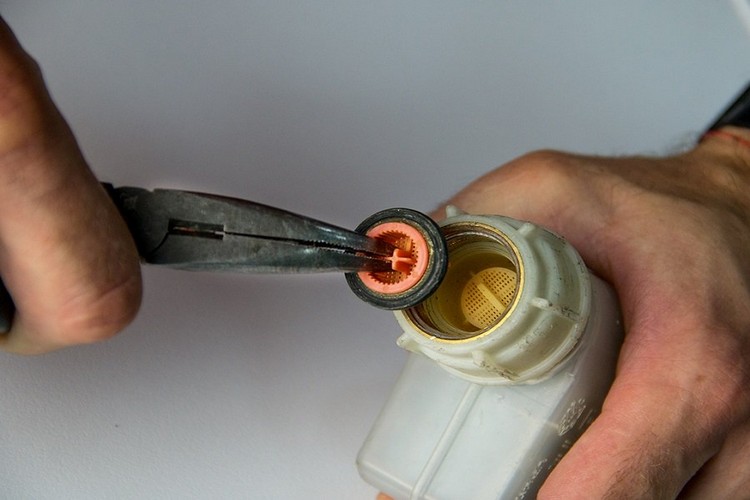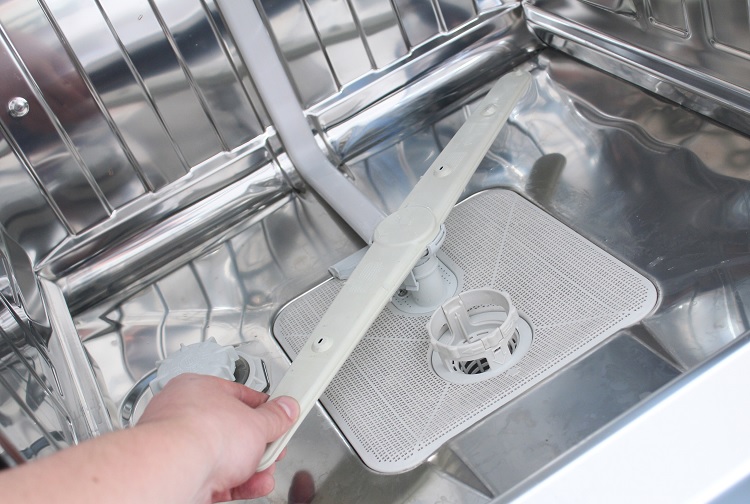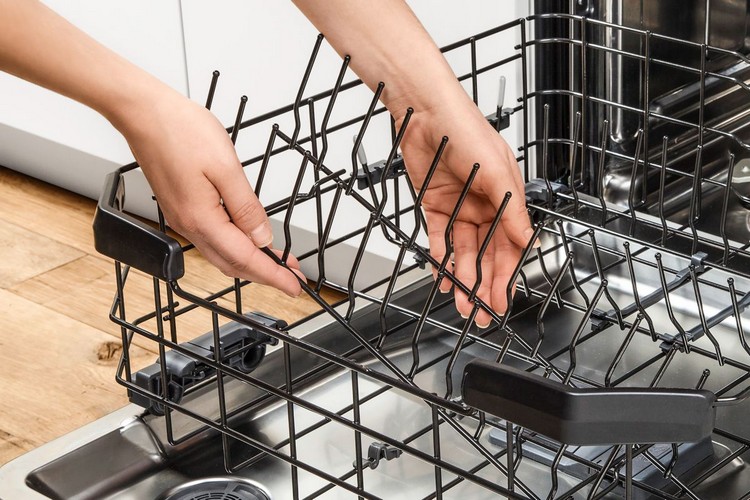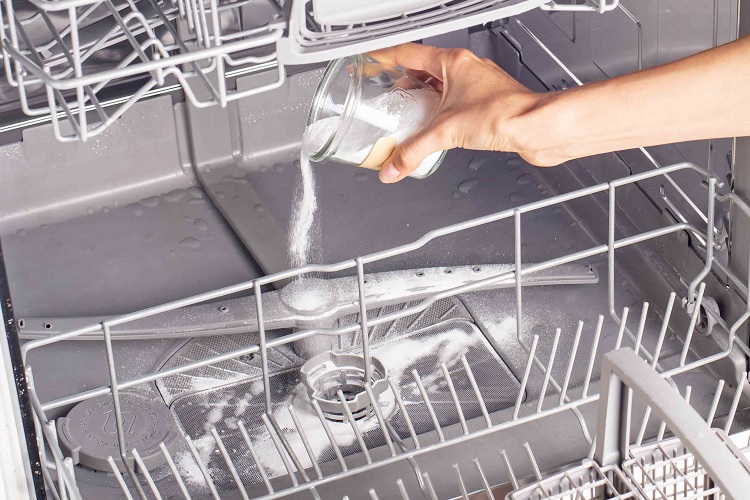Instructions: how to clean the dishwasher at home - the best cleaning tools and methods
 The dishwasher makes life much easier by removing stains on glasses, greasy films and stains, unpleasant odors and dirt from plates, pots and pans.
The dishwasher makes life much easier by removing stains on glasses, greasy films and stains, unpleasant odors and dirt from plates, pots and pans.
Despite its intended purpose, the machine does not clean itself along with the dishes, but rather slowly accumulates the collected garbage.
Without timely care, the dishwasher will no longer cope with its work, dirt will remain on the dishes, the drain will work too slowly. There will also be a number of problems, due to which it may seem that the dishwasher has worked its way, but this is not so.
To prevent such consequences, it is recommended to carry out a comprehensive cleaning of PMM.
Content
- About dishwasher dirt
- Cleaning dishwasher filters
- Cleaning sprinklers from debris
- The process of manual cleaning of the dishwasher pump
- Washing baskets and racks of the dishwasher
- Washing the interior of the dishwasher
- Special cleaners
- Cleaning with improvised means
- Contamination prevention for extended service life
- Useful video
About dishwasher dirt
Like any other appliance, the dishwasher is subject to contamination, and manufacturers recommend cleaning it at least once a month. This can be done less frequently depending on the frequency of use.
The degree and rate of contamination of the dishwasher depends on several factors:
- The machine runs once a day or more;
- The door remains closed after washing. In this case, there is a risk of mold inside the appliance;
- Hard water without softening dishwasher salt;
- Very dirty dishes: with leftover food, burnt parts and congealed fat;
- Washing at low water temperature;
- Washing plastic or wooden utensils not intended for the machine.
There are also several signs that signal that the dishwasher needs cleaning:
- Bad smell inside;
- Remaining dirt or white streaks on dishes after washing in a typewriter;
- Remaining food inside the chamber;
- plaque on the filter;
- Water begins to drain more slowly than usual.
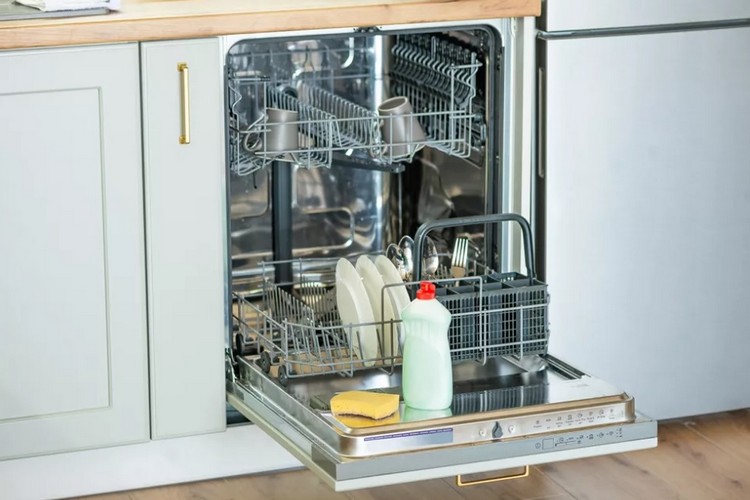
Cleaning dishwasher filters
Every dishwasher has two filters.
The first cleans the water in the unit from sand, small metal particles and impurities, the second cleans the water that drains from the dishwasher, preventing blockages in the drain.
As a rule, before loading into the machine, the dishes must be cleaned of excess dirt and food debris by rinsing in warm water. But it is impossible to get rid of the excess at once, and thorough washing makes the dishwasher useless.
Its filters are designed to process small particles, after restarting they are washed off with water to the bottom of the washing chamber.
Clogging of these filters can lead to several problems at once:
- The machine will become too noisy;
- The dishes will remain dirty;
- The water will drain too slowly;
- There will be an unpleasant odor.
Cleaning the trash filter of the dishwasher
The drain cleaning filter is located at the bottom of the wash chamber, it can be easily removed if all the dish baskets are removed first. The filter is usually located under the water sprinkler and removed by unscrewing it clockwise.
The filter consists of several parts that are attached to each other. It is easy to separate them in order to rinse each one separately, the filter is assembled back on an intuitive level, as well as according to the instructions attached to the dishwasher.
Rinse the filter under running water.
But if a strong coating remains on it, then it is permissible to use chemical and natural detergents for cleaning:
- Laundry soap;
- Dishwashing liquid;
- Baking soda;
- Salt;
- Vinegar;
- Lemon acid.
Brushes and toothpicks can be used to clean the filter grilles.
Cleaning the dishwasher inlet filter
The water supply valve filter clogs more slowly than a garbage filter, but this does not mean that you can forget about it. The degree of its clogging directly depends on the hardness of the water, the harder the water, the more often it is necessary to clean it.
In the event that a blockage forms in the valve filter, there is a risk of stopping the water intake.
In order to clean the inlet filter, you need to turn off the power to the unit and stop the water supply. Then unscrew the inlet hose and remove the filter from its seat.
It is washed in exactly the same way under water. Usually, it is not necessary to use chemicals to clean it, as is the case with a cleaning filter.
Cleaning sprinklers from debris
The sprinkler can easily disable the dishwasher, because despite the fact that the water from the hose has already been cleaned of large particles, it still contains microsand and calcium salt, which the filter passes through.
To clean the sprayer:
- Remove the basket with the rocker, including the lower level;
- Bend the latches and the sprayer blades, pulling them up;
- Inspect seals;
- Rinse the blades, nozzles and assemblies under plain water;
- Return everything to its original position.
Despite the fact that fasteners may differ from each other on different PMMs, they have the same assembly principle. For proper assembly, you must use the instructions that came with the dishwasher.
The process of manual cleaning of the dishwasher pump
The pump in the dishwasher is an important element of the system, it ensures the circulation of water and washing liquid inside the machine.
The system is made to save water when rinsing, soaking and washing dishes. If the quality of washing dishes has changed dramatically, the cause may be a dirty pump, but it should be cleaned carefully.
The pump may be blocked by large food residues or foreign objects.
Before cleaning, the dishwasher must be unplugged from the mains.
Then follow the simple instructions:
- Take out the upper and lower basket;
- Extract all filters;
- Drain all the water from the machine;
- Lift the pump cover with an object, take the cover by the tongue and pull it out completely;
- Check the impeller for integrity;
- If there are foreign objects, they must be carefully removed;
After checking, it is necessary to reassemble. It is also important to note that when cleaning the pump, in no case should the protection be removed.
Washing baskets and racks of the dishwasher
Baskets are slatted trays that hold utensils, but they can also accumulate grease, food debris, and fibers.
The principle of cleaning grates and baskets is practically the same as cleaning other parts. To do this, you can take a brush, soft microfiber cloths or a sponge for washing dishes.
Baskets must first be removed from the dishwasher, then it is advisable to soak them in a solution of detergent for several minutes. Parts that cannot be removed from the machine will have to be cleaned and washed directly in it, pushing them as far forward as possible.
With the help of a brush and sponges, you need to remove all the remnants of food and dirt, and then wipe the grates with a sponge from all sides.
For hard-to-reach places, an old toothbrush is suitable, you can use medium hard bristles, they will not damage the dishwasher.
Washing the interior of the dishwasher
The dishwasher chamber should be washed last, this is the final part of the whole procedure. But it should only be touched if there are no large contaminants on other parts of the machine.
Cleaning the PMM camera is carried out in several steps:
- It is necessary to prepare a detergent, in this case, manufacturers recommend resorting to the use of special products for dishwashers, as they safely remove grease, mold and rust;
- In the instructions for the dishwasher, you need to find a section that describes in detail the cleaning mode, in which it is necessary to fill in the detergent and start washing at the highest temperature.
As soon as the wash is over, you can pour a glass of soda on the bottom, leave the car for several hours and then wash the residue. The self-cleaning of the dishwasher will be completed.
Special cleaners
To clean the dishwasher at home, it is best to choose a special tool designed for this.
First of all, the use of this product will prolong the operation of the machine, since the composition is chosen so that it does not harm the equipment and its parts that cannot be removed for washing.
The price of such funds is usually not the lowest, so it is important to pay attention to the composition, not only for the safety of the car, but also for your own safety. Unscrupulous manufacturers can replace the product with aggressive chemicals that are dangerous to human health.
Special tools are easy to apply. They are poured into the powder compartment and clean the machine in the washing mode.
Liquids from scale and grease
Often, special dishwasher products are already predisposed to cleaning grease and scale, their main task is to completely clean the dishwasher.
To do this, you can use the following brands:
- Henkel Somat Machine Cleaner;
- milit;
- Reinex.
Cleaning with improvised means
Not everyone likes to use household chemicals to clean appliances and prefer to use other classic options that clean the dishwasher from dirt no less effectively.
It can be a powder, solution, dish detergent or special tablets.
Vinegar
This is a very aggressive substance and at first glance it seems that vinegar is able to clean everything. So it is, but you need to be careful when using vinegar, as it can have a negative effect on the rubber inside the dishwasher and on its parts.
If vinegar is used, then in small proportions and extremely rarely.
Bura
Sodium borate is a commonly used cleaning method.
The solution is mixed with plain water. In the resulting mixture, you need to moisten the sponge and wipe the working cavities, seals and other parts with it.
The solution can also be poured into the powder compartment in the same way and the machine can be switched on in the washing mode.
Lemon acid
This is a universal and least harmful composition.
The mixture will remove scale, grease, rust and mold, and the amount of citric acid determines the level of soiling of the machine.
For an average level of contamination, 300 grams will be required, which must be poured into the powder compartment. This amount of acid is enough to put the dishwasher in order.
Contamination prevention for extended service life
There are a few simple tips that will reduce the risk of dishwasher failure and increase its lifespan:
- After each wash, you need to leave the door ajar so that the moisture leaves faster and does not provoke the appearance of mold;
- After use, it is advisable to wipe the rubber bands inside the machine with a dry cloth, and the doors outside with a damp one;
- For cleaning in the washing mode, it is recommended to use special products and rarely resort to other methods, since with frequent use they can backfire and affect performance;
- Clean your dishwasher weekly.
Following the recommendations from the first days of use, the dishwasher will not only last longer, but will also not take much time on the days allotted for cleaning it.
Daily care will facilitate the process and eliminate the need for the use of aggressive chemicals. The technique is not demanding in maintenance, if it is carried out in a timely manner.
Useful video
All the nuances of cleaning the dishwasher at home are shown in the video plot:




